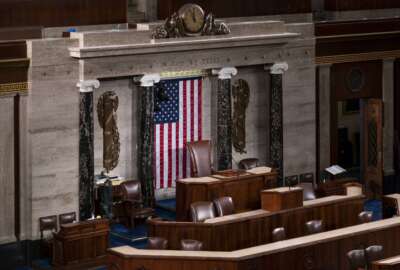Mobile workforce changing look of federal workspace
The General Services Administration is turning its own headquarters into a \"living laboratory\" by putting three employees into the space of one. GSA\'s Cathy ...
wfedstaff | June 3, 2015 8:52 pm
By Suzanne Kubota
Senior Internet Editor
FederalNewsRadio.com
Alternative work schedules and a more mobile workforce aren’t just a theory in the federal government any more. The General Services Administration is making them as real as the real estate and buildings federal employees work in.
Cathy Kronopolus, the Regional Commissioner for GSA’s National Capital Region in the Public Buildings Service told Federal News Radio that by incorporating the ideas of both sustainability and efficiency, the federal government won’t need additional square footage and can drive the market at the same time.
She pointed to “projects like St. Elizabeths (DHS), the Department of Veterans Affairs headquarters, GSA’s own headquarters to name a few” and the Health and Human Services’ Parklawn campus as examples.
With HHS at Parklawn, said Kronopolus, “it’s too soon to tell because the procurement’s underway of what will happen with that, but typically what happens is the agency’s requirements drive them to be in a particular place, and when they re-up because they have an expiring lease, they usually stay within the same jurisdiction because you have move costs for employees and transportation costs that change, et cetera, but it’s not unheard of.”
Surprisingly, greener buildings don’t cost more than older buildings. She explained, “we are now reaching a tipping point where the cost differential is… I don’t know if it’s de minimis yet, but it’s getting there. And the long term costs, the return on investment over the lifecycle of the property is just huge. I mean it makes good business sense. That’s why the private sector’s going that way.”
Kronopolus noted there are short term gains to be realized with greener buildings, describing them as “actually sort of a talent magnet. Newcomers to the workforce are looking for being able to have some daylight, which helps with sustainability ratings, and not being in buildings with no natural light reaching them.”
The second part of what GSA is looking for might not be as immediately visible to the average employee. It will be well after 2011, Kronopolus said when users will be able to appreciate that GSA is “looking at really doing design work on the interior space to make it as adaptable as possible, and what that does is it really drives and supports alternative work strategies and mobility where you can go to the extreme of free-addressing in a building where no one has an assigned seat to where you have assigned seats, but you have much smaller square footage used by each employee because they’re out mobile working in different locations or teleworking. So it just provides an opportunity to meet some of the Executive Orders as well as sort of what the private sector is doing to really look at driving costs down and moving towards more mobility overall.”
That mobility is expected to drive down demand for square footage, which will increase both cost savings and space use efficiency.
After that, said Kronopolus, “the next phases will be what we’re calling living labs. That would be where you don’t need to go get a prospectus from (Capitol Hill) and you can use the current operating budget money to work and do a laboratory space where you try some of this mobility work.”
Getting people comfortable with those living laboratories “to see how can you really accommodate taking the money out of the real estate to the extent that it makes sense and putting into agency mission. It’s not going to happen overnight.”
This “next edge,” as GSA calls it, is going on now in the agency’s own headquarters. “Our 1800 F building (GSA’s current headquarters address) is an example,” said Kronopolus. “We’re going to be moving…three people in where one person sat in the past.”
At least in theory.
“GSA studies of real-time occupancy of work space observed 22 workplaces across 5 agencies for two-week periods and found that employees are typically only at their desks one-third of the time,” according to a June 2010 white paper.
So the notion of putting three employees in the space formerly used by one isn’t that much of a leap, said Kronopolus. “We think it’s workable, but it will definitely involve change management.”
While she described the changes as “huge,” “exciting,” and “big,” Kronopolus said to expect a gradual reshaping of demand “and that’s going to take some time.”
Copyright © 2024 Federal News Network. All rights reserved. This website is not intended for users located within the European Economic Area.





